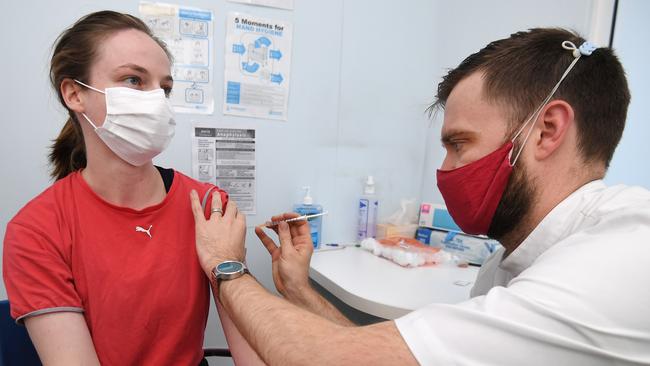Covid-19: Omicron blamed for fewer boosters
The impetus to have a booster shot is waning, with 30 per cent of Australians yet to have a third dose of a Covid vaccine.

The impetus to have a booster shot is waning across Australia, with 30 per cent of the population yet to have a third dose of a Covid vaccine.
Analysis by The Australian of the daily uptake of second doses to booster shots, finds similar numbers of people received jabs up to the point where about 12 million had been inoculated.
From that point the numbers having a third dose flattened out quickly, while those having a second dose continued to climb to more than 20 million people before starting to slow.
Health experts have blamed waning booster numbers on the relaxation of vaccine mandates and public perception that the Omicron variant is “mild”.
Clinical epidemiologist professor Nancy Baxter said there had been a tendency to minimise the impact of Covid-19 since the Omicron wave hit Australia, despite rising case numbers and hospitalisations.
“The message that I think the public has received is that it’s not really much of a problem, that Omicron is mild, and so then one would anticipate that people would feel less of an impetus to get vaccinated,” Professor Baxter said.
“I do think the mandates were a powerful influence. And because in most states and territories, being boostered wasn’t part of the requirement to work, I think that lowered the uptake of the booster.”
Epidemiologist and biostatistician Adrian Esterman said it was the “high risk proportion” of the population – those aged over 60 or with compromised immune systems – who made the conscious effort to get vaccinated.
“They’re the ones who quickly took their second dose and then, as soon as it was available, took up their third and now fourth doses. So that’s why we saw this very, very quick uptake,” Professor Esterman said. “But now we’ve got the rump of the population who really aren’t that fast and therefore, we’re stuck at about 70 per cent.”
The latest health department data shows nearly 14 million people – or 70.5 per cent of the eligible population – have received three or more doses of a vaccine, compared to more than 95 per cent of Australians aged over 16 who are double vaccinated.
Nearly 60 per cent of people aged over 65 have received four or more doses.
“Ninety-five per cent of the population has had two doses, and that still gives some protection against serious illness and even death with the most recent BA. 4 and BA. 5 sub-variants,” Professor Esterman said.
“But one of the problems is that these new sub-variants are so transmissible and can so easily invade our immune system that two doses really aren’t cutting it.
“What we’re now seeing is more and more people being reinfected and potentially even getting it three or four times. We are starting to see case numbers, hospitalisations and deaths going up and that will continue.”
Australia recorded nearly 30,000 new Covid infections on Monday, with Victoria alone reporting 24 deaths. It follows a grim milestone reached on the weekend, with the nation surpassing more than 10,000 Covid-related deaths.



To join the conversation, please log in. Don't have an account? Register
Join the conversation, you are commenting as Logout